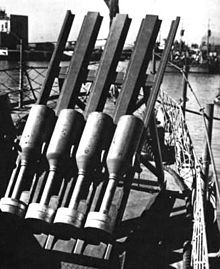Mousetrap (weapon)

Mousetrap (ASW Marks 20 and 22) was an anti-submarine rocket used mainly during the World War II by the United States Navy[1] and the U.S. Coast Guard.[2] Its development began in 1941 as a replacement for Hedgehog, a British-made projector, which was the first forward-throwing ASW weapon. Those, however, were spigot-launched, placing considerable strain on the launching vessel's deck, whereas Mousetrap was rocket-propelled. As a result, Mousetrap's four or eight rails for 7.2-inch (183 mm) rockets saved weight and were easier to install.
The rockets weighed 65 pounds (29 kg) each, with a 33-pound (15 kg) Torpex warhead and contact pistol, exactly like Hedgehog.
By the end of the war, over 100 Mousetrap Mark 22s were mounted in U.S. Navy ships, including three each on 12 destroyers,[1] and submarine chasers (usually two sets of rails).[3]
Statistics[]
- Round weight: 65 lb (29 kg)
- Warhead: 33 lb (15 kg)
- Range: about 280 m
- Firing speed: one round every 3 seconds (maximum)
- No. of rails:
- Mark 20: 4
- Mark 22: 8
Citations[]
- ^ a b "Anti-Submarine Projector Mk 20 & 22 (Mousetrap)". Microworks.net. Retrieved 2013-12-12.
- ^ "CUYAHOGA, 1927". US Coast Guard. November 2001. Archived from the original on 2008-10-03. Retrieved 2008-10-08.
- ^ "Submarine Chaser SC-718". NavSource Naval History.
Bibliography[]
- Fitzsimons, Bernard, ed. (1978). "Mousetrap". The Illustrated Encyclopedia of Twentieth Century Weapons and Warfare. Vol. 18. London: Phoebus Publishing. pp. 1946–1947. OCLC 271437802.
External links[]
| Wikimedia Commons has media related to Mousetrap anti-submarine rocket. |
- Anti-submarine missiles of the United States
- Explosive weapons
- Naval weapons of the United States
- World War II weapons of the United States
- World War II naval weapons
- Military equipment introduced in the 1940s